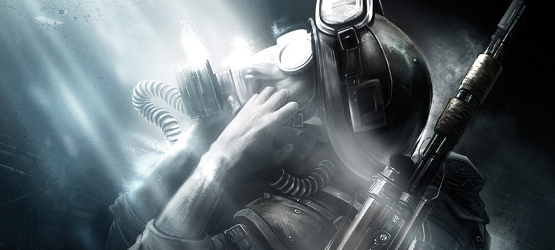
When confronted with the first person shooter genre, it’s easy to be kept in the dark about gameplay unless a demo is available. Thankfully, Metro: Last Light is comprised of the best first-person combat experiences available. Controls are tight and without lag, aiming is very precise and the game rewards tactical combat over run and gun principles.
Approaching fights with guns blazing only works on the easiest setting; on normal and above wildly shooting is the fastest way to die. Guns can be customized with barrel, stock, and sight attachments to fit a player’s style. Guns are plentiful and different enough to remain interesting. Shotguns, pistols, revolvers and the like are available, but so are pneumatic weapons which fire rounds from compressed air—a necessity in an environment without abundant resources. Weapons plucked from the corpses of fallen enemies have random customization to give the appearance that, like the player, this enemy had a specific style of shooting. Knives and a variety of explosives are also available to back up the gunplay.
If none of the above interests you, at least half of Metro: Last Light can be completed using only stealth. While the stealth mechanics in the game are not as tight as the shooting mechanics, the stealth in the game is still very good. The watch visible on protagonist Artyom’s left wrist indicates if the character is visible, and just about any light source can be destroyed or turned off to facilitate the stealth mechanics. One drawback is that enemies appear to be blind unless the player is within a light source. Thankfully, this does not have a deep impact on the difficulty—players must still be wary when dropping enemies in case the bodies are stumbled upon at a later time. Once alarmed, enemies actually wander around in a seemingly random fashion looking for the player and checking up on each other.
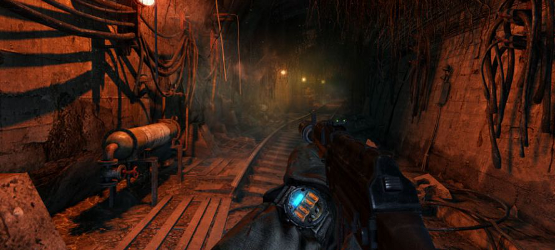
Scavenging bullets, weapons, and gas mask filters is another huge part of Metro: Last Light. Since players will often find themselves facing down Earth’s mutated wildlife when not in the Metro shooting dudes, managing air filters and not choking to death is part of surviving the game. Additionally, enemies can break Artyom’s gas mask with a well-placed shot or massive mutant claw, leaving the player to scramble for a new one before succumbing to asphyxiation.
All of the above provide a challenging experience. At normal difficulty or above, Metro: Last Light is not a game for the casual gamer. The game is hard. And outside of two memorable instances, the game does not rely on some type of fake difficulty to screw over players. Metro: Last Light requires tactics, preparation, and skill before approaching enemies. There is almost no hand-holding from the game. Players are treated like adults and are required to pay attention to their surroundings and situations. The game requires tactics, quick thinking, and raw skill to complete.
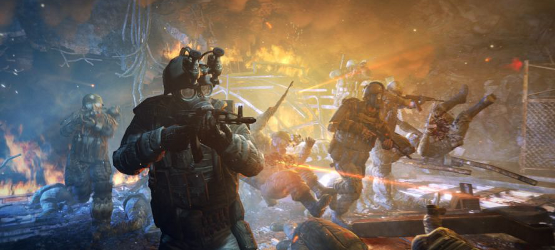
Graphically, the game is great. Character models are solid, though NPC faces tend to get reused. Environments range from the standard to the astounding. There are moments of haunting devastation. Whether it is skeletons resting in a tunnel to the surface, corpses of victims unable to outrun the mutants, or the juxtaposition of a sometimes terrifyingly bright apocalyptic overworld contrasted with a dank and unforgiving underworld. Metro: Last Light’s graphics does exactly what graphics are supposed to do: Draw the player into the world. There is occasional flickering present with rare graphical glitches, but the game does not suffer from slowdown at all.
The music and background sounds are also very well done. There are different chords and noises to let the player know if Artyom has been spotted, or all of the enemies are eliminated. These chords became very helpful in a game with very little information on what a player should be doing. The game is available in several languages and subtitle options, most notably Russian. It really adds to the setting when put in Russian.
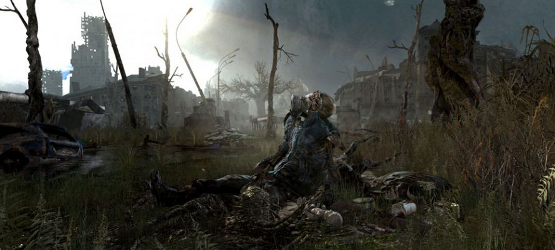
Metro: Last Light’s plot is simple. Kill the last surviving Dark One and make the Metro safe. Along the way, rescue a girl and try to stop a war from breaking out in the Metro. Most characters strive to be two dimensional at best, though a few stand out by the end of the game.
Metro: Last Light’s setting which deserves attention. Metro: Last Light is often a mature game in terms of content. The Metro has several different factions, including a group trying to establish a Fourth Reich. The game does not pull its punches with how the more warmongering factions treat the rest of the Metro. The protagonist committed genocide before the game starts to keep the Metro safe. There is well-done juxtaposition between Artyom’s childhood and the situation of the last remaining Dark One. Much of the background for the game is revealed to players who take the time to listen to NPCs throughout the game. The player will walk through accurate depictions of charnel houses. Finally, there are times when the player is given the option to save someone—mostly women and children—from being hurt. It takes a stern heart to walk away from the cries of an NPC being threatened with rape. I couldn’t do it.
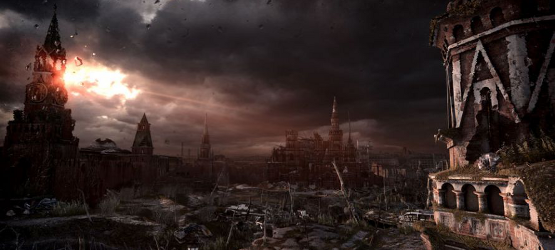
On the other hand, there are times when Last Light is exceedingly childish; akin to a boy’s fantasy. The narrative flops occasionally and awkwardly in-between political maneuvering, psychic episodes, and reflections on humanity. The Metro apparently has a very small female population either in danger of being menaced or ignored. The player saves a female character and is sexually rewarded by her. The greatest number of female NPCs present at any time in the game is either when the theater troupe performs a Jello-chested version of the Can-can dance, or when the player briefly infiltrates a brothel. Even though Artyom is focused on the mission, the option to get a viewable lap dance is still available. For a game with some very real depictions of humanity, having 50% of the population relegated to the above is an odd directorial choice. The word bitch is also thrown around by enemies so often it eventually became annoying to hear. The ending feels out of whack; taking another narrative shift towards the awkward.
Metro: Last Light is not without its bugs. Twice the game crashed in-between levels. Once all of the enemies on-screen froze yet were still issuing orders and verbally reacting to the situation. When a stealth kill was attempted on a frozen enemy, the game crashed. The ending also froze up, leaving only a still picture and the earned trophy on the screen while the audio kept playing. A reset was necessary for all instances.
Despite its childish parts and bugs, Metro: Last Light is an experience to be played. The gameplay is among the best of first-person games and doesn’t hold the player’s hand. The world is well-fleshed out and at times, stands out among video games. The game is also just hard to put down, and offers a challenging single-player experience without being impossible. Replay value is decent due to the different ways a player can accomplish goals in the game and the associated trophies for doing so. I would never recommend it to a casual player; but to everyone else searching for a challenging single player first-person game—Metro: Last Light is what you have been waiting for.
-
Great Gameplay
-
Challenging
-
Mature Themes
-
Great Setting
-
Awkward Narrative at Times
-
Crashes Occasionally








